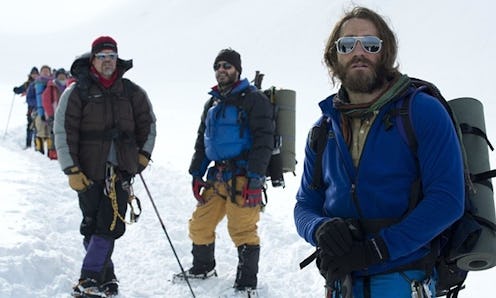
The new film Everest depicts the harrowing events of the 1996 Mount Everest Disaster, in which eight people lost their lives atop the world's tallest mountain when they were struck by a freak storm. The film does a good job of showcasing the numerous dangers of the mountain, a place rightfully considered to be one of the most dangerous in the world. Rising over 29,000 feet above sea level, it's the highest point on earth. So if you were crazy — I mean brave – enough to take on the challenge, how do you actually climb Everest? Not without caution; as the movie's trailer states, that mountain's is roughly the same as the cruising altitude of a 747, and life at that level is extraordinarily difficult for human beings. There's very little oxygen and it's bitterly cold. In addition to the height, Everest holds numerous other dangers, from very difficult terrain to devastating earthquakes and avalanches.
First and foremost, you're going to need a lot of money. Nobody, other than an experienced Sherpa or maybe a Yeti, is getting up the mountain without a pile of dough. A permit to climb the mountain is a whopping $11,000, but you can't just climb the mountain once you're there. You're going to need help. A lot of help. Hiring Sherpas to help you is going to set you back another $4,000 a pop at least, and you're going to need a bunch of them. If you're really loaded, you can hire a fancy Western company to take you up with Sherpas, bottled oxygen, and a Western guide all included for $100,000. Other mandatory costs that add up include medical and life insurance (at least $500), a pollution fee ($600), and a liaison officer ($2,500). Of course, before you'll even get to Everest you'll have spent thousands on training, equipment, and travel to Nepal, but if you have the money to climb Everest, then these expenses are just a drop in the bucket.
You're also going to need a lot of time off. The average time it takes an expedition to climb Mount Everest is two months. That's one-sixth of a year spent doing nothing but climbing a mountain in an extremely harsh climate. In addition to the many days spent on the mountain, you're also going to spend a lot of time preparing for your climb. It's recommended that all climbers have previously climbed a summit of at least 20,000 feet before, as well as spending a year of specific physical training before attempting the climb. You should already be in excellent shape before even beginning the conditioning program, but once you start the training should focus on simulating the strength and conditioning necessary to climb 4,000 feet of elevation per day while carrying 50-60 pounds of equipment. In other words, it's intense.
Besides the physical training, you'll also need to prepare yourself mentally. There's a lot of resting on the way up so your body can acclimate to the change in elevation, so you'll need to practice patience. You also need to make yourself aware of the risks, and not just the physical ones. Improper acclimation on the mountain can cause hallucinations, delirium, and other mental issues that can be extremely dangerous, so you'll need to be ready for them if they occur. Somewhat surprisingly, studies show that visualizing yourself successfully climbing the mountain beforehand actually increases your odds of success. Call it mind over mountain because you're gonna have to get used to positive thinking if you're planning on making the trek.
To make it up the mountain, you need way more gear than you think. Multiple tents; different types of ropes, axes, picks, and carabiners; and several types of shoes, gloves, clothing, and head gear for all types of weather situations. You do not want to be stuck up on the mountain and be unprepared when the weather suddenly changes. You're also going to need plenty of bottled oxygen if you plan on being able to breathe above 26,000 feet, an area known as the Death Zone, since humans cannot survive at this elevation without it.
Climbing Everest is no easy feat. If you don't want to die, you need to have money and bee prepared, have a lot of time, and be in excellent physical and mental condition. In other news, I am never climbing Mount Everest.
Images: Universal Pictures; Giphy (4)